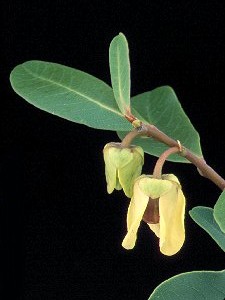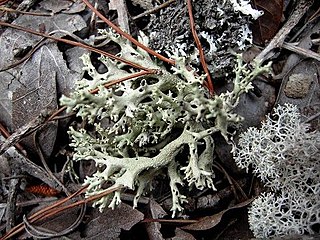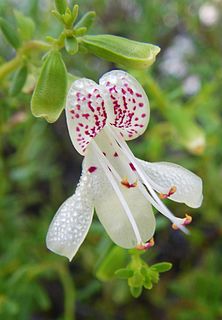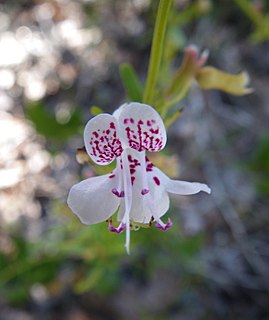| Lupinus aridorum | |
|---|---|
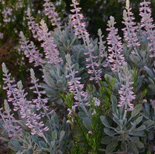 | |
| Scientific classification | |
| Kingdom: | Plantae |
| Clade: | Angiosperms |
| Clade: | Eudicots |
| Clade: | Rosids |
| Order: | Fabales |
| Family: | Fabaceae |
| Genus: | Lupinus |
| Species: | L. aridorum |
| Binomial name | |
| Lupinus aridorum McFarlin ex Beckner | |
Lupinus aridorum is a rare species of lupine known by the common name scrub lupine. It is endemic to Florida in the United States, where there were 10 known populations remaining in 2003. [1] Fewer than 6000 individual plants were counted. [1] It is threatened by the loss and degradation of its habitat. The scrub lupine is a federally listed endangered species of the United States.

Lupinus, commonly known as lupin or lupine, is a genus of flowering plants in the legume family, Fabaceae. The genus includes over 200 species, with centers of diversity in North and South America. Smaller centers occur in North Africa and the Mediterranean. They are widely cultivated, both as a food source and as ornamental plants.

Endemism is the ecological state of a species being unique to a defined geographic location, such as an island, nation, country or other defined zone, or habitat type; organisms that are indigenous to a place are not endemic to it if they are also found elsewhere. The extreme opposite of endemism is cosmopolitan distribution. An alternative term for a species that is endemic is precinctive, which applies to species that are restricted to a defined geographical area.

Florida is the southernmost contiguous state in the United States. The state is bordered to the west by the Gulf of Mexico, to the northwest by Alabama, to the north by Georgia, to the east by the Atlantic Ocean, and to the south by the Straits of Florida. Florida is the 22nd-most extensive, the 3rd-most populous, and the 8th-most densely populated of the U.S. states. Jacksonville is the most populous municipality in the state and the largest city by area in the contiguous United States. The Miami metropolitan area is Florida's most populous urban area. Tallahassee is the state's capital.
This plant was first collected in 1900, but it was not described until 1982 to science as a species. [2] It is often treated as a variety of Lupinus westianus . [3]
In botanical nomenclature, variety is a taxonomic rank below that of species and subspecies, but above that of form. As such, it gets a three-part infraspecific name. It is sometimes recommended that the subspecies rank should be used to recognize geographic distinctiveness, whereas the variety rank is appropriate if the taxon is seen throughout the geographic range of the species.
The scrub lupine is a biennial or perennial herb growing up to a meter tall. The leaves are oval with pointed tips, not palmate as in most other lupines. Each leaf blade may be up to 7 centimeters long by 4 wide and is borne on a long petiole. The herbage is coated in silvery hairs. The inflorescence is a raceme-like spike of flowers up to 15 centimeters long borne on an erect stalk up to 13 centimeters in length. Each pealike flower is between 1 and 2 centimeters long and pale pink in color with a darker spot on the standard, or top, petal. The fruit is a hairy legume pod about 2 centimeters long. The plant is known to reach seven feet in diameter. [2] The scrub lupine is easily identified in its habitat, being the only upright-growing lupine that has pink flowers. [2]

In botany, the petiole is the stalk that attaches the leaf blade to the stem. Outgrowths appearing on each side of the petiole in some species are called stipules. Leaves lacking a petiole are called sessile or epetiolate.

An inflorescence is a group or cluster of flowers arranged on a stem that is composed of a main branch or a complicated arrangement of branches. Morphologically, it is the modified part of the shoot of seed plants where flowers are formed. The modifications can involve the length and the nature of the internodes and the phyllotaxis, as well as variations in the proportions, compressions, swellings, adnations, connations and reduction of main and secondary axes. Inflorescence can also be defined as the reproductive portion of a plant that bears a cluster of flowers in a specific pattern.
A raceme is an unbranched, indeterminate type of inflorescence bearing pedicellate flowers along its axis. In botany, an axis means a shoot, in this case one bearing the flowers. In indeterminate inflorescence-like racemes, the oldest flowers are borne towards the base and new flowers are produced as the shoot grows, with no predetermined growth limit. A plant that flowers on a showy raceme may have this reflected in its scientific name, e.g. Cimicifuga racemosa. A compound raceme, also called a panicle, has a branching main axis. Examples of racemes occur on mustard and radish plants.
The plant grows in the Florida scrub of Central Florida. It grows in well-drained white sand, or sometimes yellow sand, among sand pines (Pinus clausa). Other trees in the habitat may include slash pine (Pinus elliottii) and turkey oak (Quercus laevis). Shrubs in the understory include the Florida rosemary (Ceratiola ericoides), scrub live oak (Quercus geminata), and rusty lyonia (Lyonia ferruginea). [2]

Florida sand pine scrub is an endangered subtropical forest ecoregion found throughout Florida in the United States. It is found on coastal and inland sand ridges and is characterized by an evergreen xeromorphic plant community dominated by shrubs and dwarf oaks. Because the low-nutrient sandy soils do not retain moisture, the ecosystem is effectively an arid one. Wildfires infrequently occur in the Florida scrub. Most of the annual rainfall falls in summer. It is endangered by residential, commercial and agricultural development, with the largest remaining block in and around the Ocala National Forest. Lake Wales Ridge National Wildlife Refuge also holds a high proportion of remaining scrub habitat, while the Archbold Biological Station near Lake Placid contains about 20 km2 (7.7 sq mi) of scrub habitat and sponsors biological research on it.

Central Florida is a region of the Southern U.S. state of Florida. Different sources give different definitions for the region, but as its name implies it is usually said to comprise the central part of the state, including the Orlando area. It is one of Florida's three directional regions, along with North Florida and South Florida. It includes the following counties: Brevard, Citrus, Hardee, Hernando, Hillsborough, Indian River, Lake, Manatee, Marion, Orange, Osceola, Pasco, Pinellas, Polk, Seminole, Sumter, and Volusia.

Pinus clausa is a species of pine endemic to the Southeastern United States. Its common names include sand pine, Florida spruce pine, Alabama pine, and scrub pine.
The Florida scrub is a highly endangered habitat type, and the lupine is mainly found in degraded strips or in areas that are in danger of being destroyed for development. The only known populations are in Orange and Polk Counties, areas of rapid growth and rapid loss of natural habitat. When it was listed under the Endangered Species Act, the lupine was only found on private property which could not be protected. [2] Since the last count in 2003, three to four of the 10 known populations have likely been extirpated. Some sites are protected today, including at least one within the Lake Wales Ridge National Wildlife Refuge; this is the only site that is guaranteed long-term protection from development. [1]
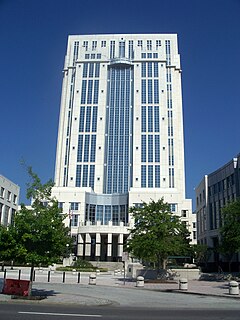
Orange County is a county in the state of Florida, in the United States. As of the 2010 census, the population was 1,145,956, making it Florida's fifth-most populous county. The county seat is Orlando.

Polk County is located in the U.S. state of Florida. The county population was 602,095, as of the 2010 census. Its county seat is Bartow, and its largest city is Lakeland.
Local extinction or extirpation is the condition of a species that ceases to exist in the chosen geographic area of study, though it still exists elsewhere. Local extinctions are contrasted with global extinctions.
The main threat to the species is the loss of its habitat to development and the improper management of remaining habitat. When it was listed, most of the occurrences were located between Orlando, Florida, and the Walt Disney World complex, an area of busy growth. [2] Land is being cleared for housing developments and related utilities, such as roads, and because most of the occurrences are still privately owned, they could be cleared at any time. [1] [2] Remaining habitat is affected by fire suppression. The Florida scrub is an ecosystem which depends on a normal regime of periodic wildfires for maintenance. Fire is largely prevented today in an effort to protect property, so the scrub lands become overgrown and plants, such as the lupine, that require open, bare spots for sunlight become shaded out. Most of the lupine's habitat is now degraded because it has gone without fire or mechanical removal of brush and vegetation. [1]

Orlando is a city in the U.S. state of Florida and the county seat of Orange County. Located in Central Florida, it is the center of the Orlando metropolitan area, which had a population of 2,509,831, according to U.S. Census Bureau figures released in July 2017. These figures make it the 23rd-largest metropolitan area in the United States, the sixth-largest metropolitan area in the Southern United States, and the third-largest metropolitan area in Florida. As of 2015, Orlando had an estimated city-proper population of 280,257, making it the 73rd-largest city in the United States, the fourth-largest city in Florida, and the state's largest inland city.

The Walt Disney World Resort, also called Walt Disney World and Disney World, is an entertainment complex in Bay Lake and Lake Buena Vista, Florida, in the United States, near the cities Orlando and Kissimmee. Opened on October 1, 1971, the resort is owned and operated by Disney Parks, Experiences and Products, a division of The Walt Disney Company. It was first operated by Walt Disney World Company. The property, which covers nearly 25,000 acres, only half of which has been used, comprises four theme parks, two water parks, twenty-seven themed resort hotels, nine non-Disney hotels, several golf courses, a camping resort, and other entertainment venues, including the outdoor shopping center Disney Springs.

An ecosystem is a community of living organisms in conjunction with the nonliving components of their environment, interacting as a system. These biotic and abiotic components are linked together through nutrient cycles and energy flows. Energy enters the system through photosynthesis and is incorporated into plant tissue. By feeding on plants and on one-another, animals play an important role in the movement of matter and energy through the system. They also influence the quantity of plant and microbial biomass present. By breaking down dead organic matter, decomposers release carbon back to the atmosphere and facilitate nutrient cycling by converting nutrients stored in dead biomass back to a form that can be readily used by plants and other microbes.
Other threats include wilt, a disease caused by the bacterium Xylella fastidiosa . [1]
A recovery project is under way in Polk and Orange counties. The project involves planting seedlings propagated at the Rare Plant Conservation Program nursery at Bok Tower in Lake Wales. The first planting occurred at Lake Blue Scrub in Winter Haven in December 2008. Subsequent plantings have occurred at three other sites. The hope is that eventually the plants will produce enough seeds that will germinate and produce a sustainable wild population, but the results will remain unknown for several years.
The Scrub Lupine is sometimes called McFarlin's Lupine in honor of James Brigham McFarlin, a Winter Haven botanist who collected specimens in the 1930s and is thought to be the first person to suggest that it be described as a separate species. (See Notes On The Life and Work of James Brigham McFarlin, Florida Botanist Sida 22(1):607-613 2006)

